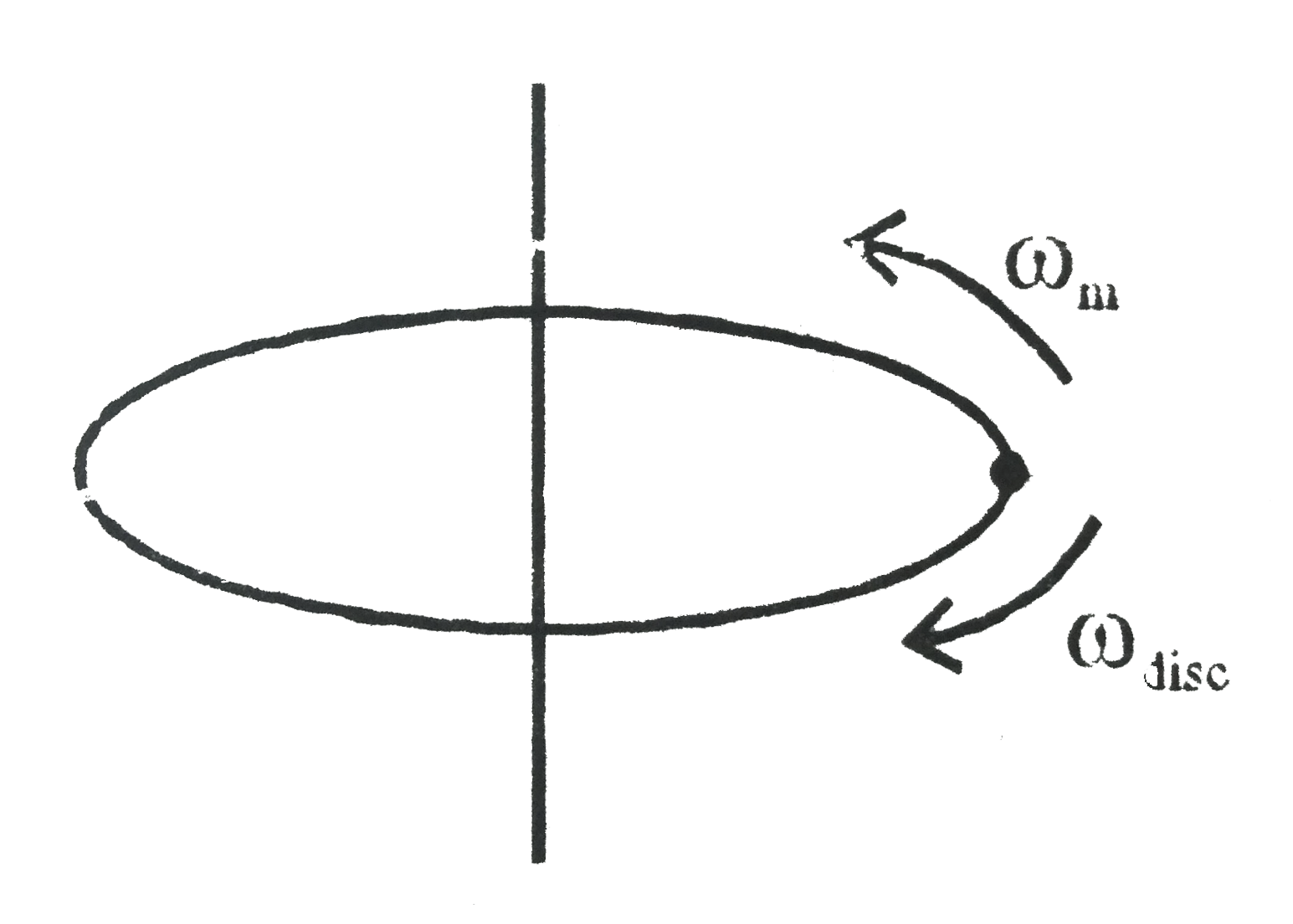A uniform circular disc can rotate freely about a rigid vertical axis through its centre O.A man stands at rest at A on the edge due east of O. The mass of the disc is 22 times the mass of the man. The man starts walking anticlockwise. When he reaches the point A after completing one rotation relative to the disc, what will be his position ?
The correct Answer is:60∘ east of south, 30∘ south of east
As no enternal torque is acting So its angular momentum will remain conserve. Since man is walking anticlockwise disc will rotate clockwise.
I1ω1=I2ω2
let θ is angle moved by disc, so in one rotation angle moved by man is (2π−θ)
mR2(2π−θ)T=12(22m)R2θT
θ=π6 or 30∘.
 .
.
Similar Questions
A circular disc of mass 300gm and radius 20cm can roate freely about a vertical axis passing through its centre of O.A small inset of mass 100gm is initially stationary) the insect starts walking from rest along the rim of the disc with such a time varying relative velocity that the disc rotates in the opposite direction with a constant angular acceleration =2πrad/s2. After some time T, the insect is back at the point A. By what angle has the disc rotated till now , as seen by a stationary earth observer ? Also find the time T.
View SolutionA uniform disc is rotating freely about a vertical axis passing through its centre and makes 100 rpm. A small piece of gum of mass 8 g falls vertically on the disc and sticks to it at a distance of 5 cm from its axis. If the number of rotations per minute reduces to 80 rpm find the moment of inertia of the disc.
View Solution
Knowledge Check
A horizontal disc rotates freely about a vertical axis through its centre. A ring, having the same mass and radius as the disc, is now gently placed on the disc. After some time, the two rotate with a common angular velocity, then
Asome friction exists between the disc and the ringBthe angular momentum of the 'disc plus ring' is conservedCthe final common angular velocity is (23)rd of the initial angular velocity of the discD(23)rd of the initial kinetic energy changes to heatA thin horizontal circular disc is rotating about a vertical axis passing through its centre. An insect is at rest at a point near the rim of the disc. The insect now moves along a diameter of the disc to reach other end. During the journey of the insect, the angular speed of the disc
Aremains unchanged.Bcontinuously decreases.Ccontinuously increases.Dfirst increases and then decreases.A thin horizontal circular disc is roating about a vertical axis passing through its centre. An insect is at rest at a point near the rim of the disc. The insect now moves along a diameter of the disc to reach its other end. During the journey of the insect, the angular speed of the disc.
Acontinuously decreasesBcomtinuously increasesCfirst increases and then decreasesDremains unchanged
A man of mass m1 stands on the edge of a horizontal uniform disc of mass m2 and radius R which is capable of rotating freely about a stationary vertical axis passing through its centre. At a certain moment the man starts moving along the edge of the disc, he shifts over an angle φ′ relative to the disc and then stops. In the process of motion the velocity of the man varies with time as v′(t).
Assuming the dimensions of the man to be negligible, find:
(a) the angle through which the disc had turned by the moment the man stopped,
(b) the force moment (relative to the rotation axis) with which the man acted on the disc in the process of motion.
View SolutionTwo horizontal discs rotate freely about a vertical axis passing through their centres. The moments of inertia of the discs relative to this axis are equal to I1 and I2, and the angular velocities to ω1 and ω2. When the upper disc fell on the lower one, both discs began rotating, after some time, as a single whole (due to friction). Find:
(a) teh steady-state angular rotation velocity of the discs,
(b) the work performed by the friction forces in this process.
View SolutionA circular disc is rotating in horizontal plane about vertical axis passing through its centre without friction with a person standing on the disc at its edge. If the person gently walks to centre of disc then its angular velocity
View SolutionA disc is free to rotate about a smooth horizontal axis passing through its centre of mass. A particle is fixed at the top of the disc. A slight push is given to the disc and it starts rotating. During the process.

View SolutionA uniform disk of mass 300kg is rotating freely about a vertical axis through its centre with constant angular velocity ω. A boy of mass 30kg starts from the centre and moves along a radius to the edge of the disk. The angular velocity of the disk now is
View Solution
